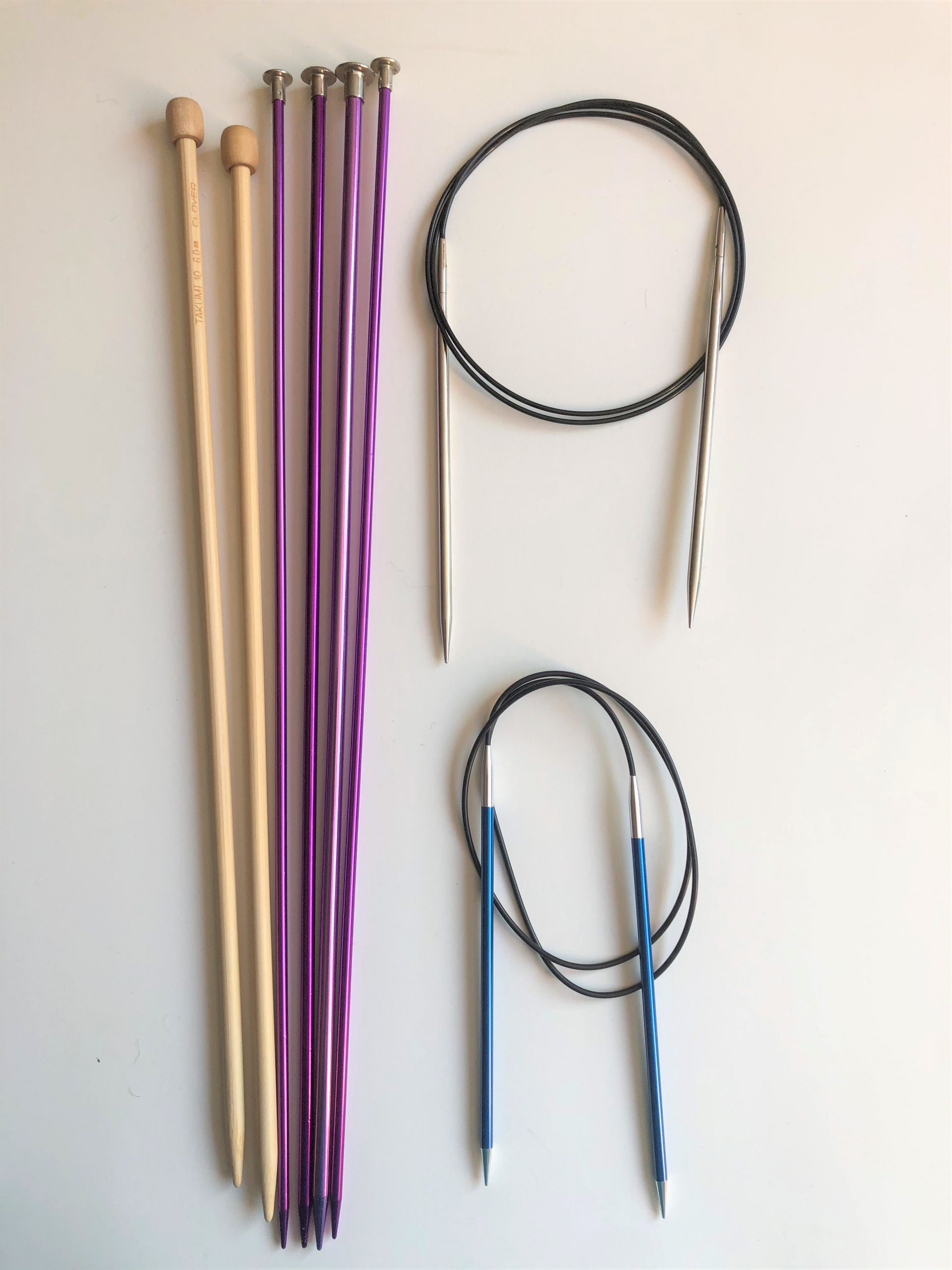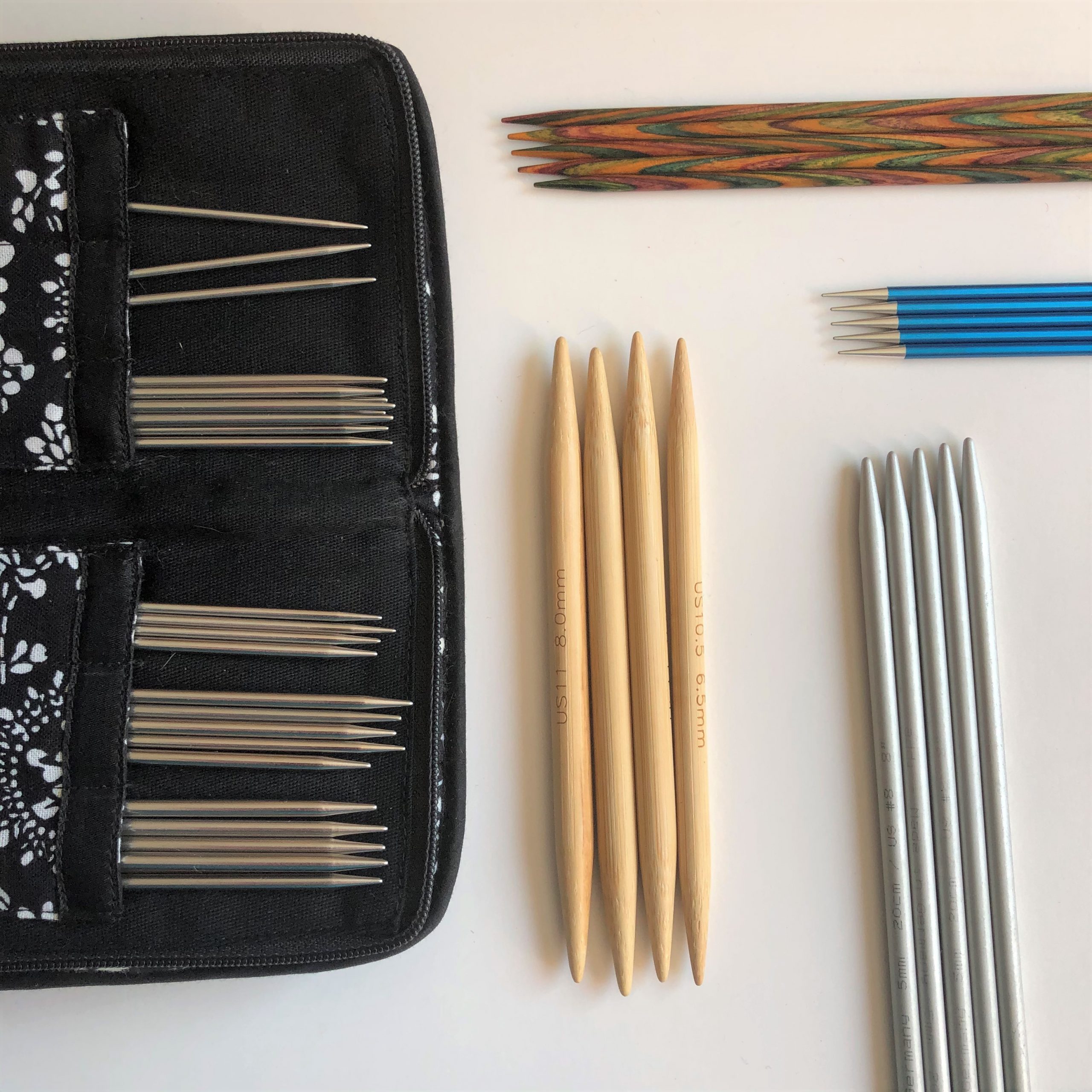Are you starting a new project? Need help choosing the right knitting needles? Check out these stats on style, points, and materials to help you choose the perfect type of knitting needle for your project!
Needle Style
Not all knitting needles are great for all knitting projects, the style of needle you choose to work with is important and should match the type of project you are creating.

Working on a scarf or seamed cardigan? Try straight needles:
Straight Knitting Needles - Yes all knitting needles have a straight section to them, but ‘straight’ knitting needles are the kind you would most commonly associate with knitting. You know the kind from story books and movies, two sticks, one end pointed and a small knob or button on the other end. This type of needle is great for narrower flat pieces of knitting, think scarf, or a sweater worked flat in pieces and then seamed together.
Want to start a Pullover worked in the round or a blanket? Circulars are what you need:
Circular Knitting Needles - Circular needles are two short needles that are joined with a flexible cable. They are exquisitely versatile since they can be used for knitting in the round AND knitting flat. Since the needles are joined with a cable they can hold a larger number of stitches making this kind of needle perfect for knitting in the round or working on larger projects like a pullover, shawl or blanket. Since the weight of the knitting rests on the flexible cable, this type of needle can be much easier on the forearms and elbows of the knitter making for a more comfortable knitting experience.

Are you small circumference knitting a sock or mitten? Double points are one way to go:
Double Pointed Needles - Double Pointed needles come in sets of 4 or 5, they are typically between 6-8 inches long and both ends are pointed. This type of needle is used for small circumference knitting where the stitches that are worked in the round are placed as evenly as possible on 3-4 needles, then worked around with the final needle. Most commonly used for hats, socks, and mittens this type of needle is excellent for decreasing areas like the top of a hat since the needles can accommodate the changing circumference.
Small circumference knitting can also use shorter circular needles, two circular needles, or one very long circular needle with the cable looped around.
Tip Type!
The type of finish that your needle tip has can affect your knitting experience and finished item.

Are you working with a plant based fiber like cotton? Or creating a beautiful Lace shawl? Sharp tips can help with that!
Sharply Pointed - Really sharp needles are great for knitting lace stitches, the narrower tips help the knitter and the needle insert into the yarn loops faster and with greater success when completing a decrease like k2tog, or ssk. Sharper tips can also help with make one increases when using a plant fiber yarn like cotton, the plant fibers yarns tend to have less elasticity and can be harder to twist into an increase. Narrower needles have a fine tip allowing the same increase with less tension.
Are you enjoying some meditative rows of stockinette or garter stitch? Middy points are a great choice to keep that zen feeling:
Snub or Middy Point - These needles are great for faster knitting, they have a wider point that is smooth and are better at not splitting the yarn. If you are working on a mostly garter stitch, or stockinette stitch item then this point style is a great choice. It also works well for loosely spun yarns like singles, novelty yarns and fuzzy yarns like mohair since typically the middy point will slide smoothly into the stitch versus getting snagged in the yarn.
Materials: What your needles are made out of matters!

Most knitters have a preference for one material type or another, and it can be helpful to switch materials now and then depending on your project.
Working with wool? Try Metal Needles:
Metal Needles - Metal Needles are great for keeping the yarn moving smoothly along the needle, they are ideal for yarns that are typically sticky like wool or mohair. If you are typically a knitter with loose tension switching to metal needles might help you tighten up, the more slippery needles will require tighter stitches thus firming up your tension.
Super Slippery Yarn? Wood Needles can help:
Wooden Needles - Wood or Bamboo needles are typically stickier to work on than metal needles. If you are using a slippery yarn like rayon or bamboo working on wooden needles can help you keep the stitches on the needles better. If you are typically a knitter with tight tension switching to wooden needles might help you loosen up, the more sticky needles will require looser stitches thus relaxing your tension.
Using a strong yarn like cotton? Plastic Needles can be flexible:
Plastic Needles - Plastic needles are light to work with and are typically stickier than metal but smoother than wood. Some knitters love the flexibility of plastic needles, especially when working with a strong yarn like cotton.
Related Videos: Choosing Your Knitting Needle: Circular vs. Straight, Choosing Your Knitting Needle: Sizes of Needles, Choosing Your Knitting Needle: Wooden vs. Metal


I'm teaching my granddaughter to knit and she is in the process of making a bulky blanket with size 50 needles. She has completed roughly 10" and the cord came off the needle. Any suggestions? I will buy another pair of needles if you can recommend a pair that will not pull apart. I got these from amazon and after I got them I saw other comments with the same situation. Please help. Thank you, Sharon Dansereau
I do not recommend using plastic needles. They tend to bend and get out of shape fairly easily. The only time I would consider using them is using very large ones for bulky yarn because of the weight of the item.
I have gone to circular needles almost exclusively. I do use straight needles for ribbing. Circular needles make knitting larger projects easier to handle for me.
Great suggestions! 👏
Thank you. As an experienced knitter I found this to be a very well done article. Those materials and tips make a huge difference in making a project less frustrating. I might grab my straight for my next sweater for fun. Excellent tips. Thank again.
I’ve just read through your ‘article’ regarding which needles to use. I was very lucky to have a relative teach me simple knitting, a scarf of course, when I was almost 5yrs old. Knitting totally fascinated me from an early age. I was so proud of it when it was about 12ins and thought I just had to pull it off the needles thankfully my aunt cast off for me😊. Right up until I was in my late 50’s I used straight needles then my knitting magazine had a free give of a cheap pair of circular needles. I tried them out thinking I’d never carry on using them. How wrong I was, I used to have a tender spot just under where the straight needle sat under my arm. I have never gone back to straights, I use them for all knitting, even if a garment has separate pieces. I struggle knitting socks with double pointers so use the circulars there too. Also I have Rheumatoid arthritis and find them easier and not a strain on my hands as much. If advising any new knitter I say try both and see which you are more comfortable using, knitting is for pleasure so use which you enjoy.👍😊
Vintage plastic needles may be smoother than bamboo, but they are not/not smoother than wood. Wood & bamboo are 2 different fibers with 2 very different finishes. Modern plastic needles tend to be sticky & not smoother than either one. You've also ignored carbon fiber needles, my preference for ultra-slippery yarns like pure silk.
Nice summary! Now I’ve memorized those tips, and I won’t have to open those huge knitting books just for that 🤣
I seem to have developed contact allergies to some types of metal. I love metal DPNs for socks - I break bamboo and wooden needless- but some shiney needles give me blisters and irritation. Any suggestions?
Enjoy the wooden knitting needles